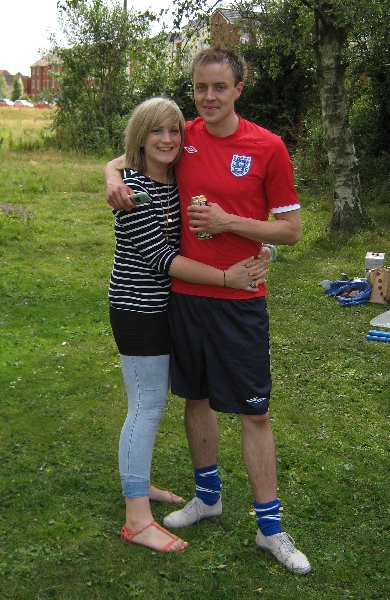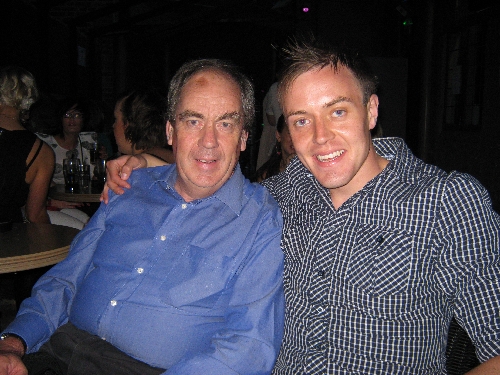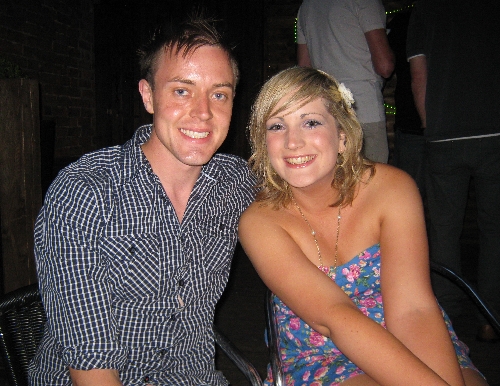
I am pleased to announce that, much to Sybille’s great pleasure, on Wednesday 20th April 2011 we became the proud owners of a dog. Strictly speaking, until a date in early October 2011, we are only the surrogate foster parents of a dog. I’ll explain that situation in greater detail in a moment. But first of all, let me introduce the dog.
Our dog, pictured here on the left, was found by the police in early April, wandering around a Prague suburb. He did not have either an ID microchip or a tattoo to identify him. But he did have a collar with a metal tag attached, which gave his date of birth & said that his name was ‘Sam’. However, rather oddly, the tag had no address or phone number.
Officially, Sam is deemed to be a Labrador mix. However, other than a few spots on his ears, there is nothing to distinguish him from a pure bred Labrador. As I have very little knowledge of dog breeds, I shall leave any detailed discussion of exactly what his breeding is, to those are more knowledgeable in these matters than I am.
We obtained Sam from the stray dog and re-homing centre, run by the police and located just across the Vltava River from where we live. We did so, by finally finding a way to circumvent the absurdities of Czech bureaucracy that I described in my earlier post in February this year entitled ‘Czech bureaucracy again’.
After our experience described in that post, we had various ideas as to how we might challenge our being treated as second-class citizens simply because we were deemed only to have ‘Temporary Residence’ in the Czech Republic. These ranged from getting the British Ambassador involved or taking our friend, an English-speaking Czech lawyer, along with us. Eventually, we decided to try the slightly less heavy-handed approach of asking a Czech-speaking member of the St. Clement’s congregation to telephone the stray dog and re-homing centre, to see if the impasse could be explained & overcome.
The person we got to help us was Karen, one of numerous ladies of that name either in my congregation or commenting on this blog! This Karen has both Czech and Australian nationality and speaks several languages fluently, including Czech and English. Having managed to speak on the phone to the man in charge of the dog centre, Karen was assured that, if she came in person with us to the centre and explained the situation, we would be allowed to adopt a dog. So on the morning of Wednesday 20th April, we met Karen outside the dog centre to see if the promise made on the phone would be fulfilled.
Unfortunately, the same very difficult and officious lady that we had met on our previous visit, was on the front desk. She gave Karen exactly the same story as we got the first time we were there – we were foreigners with ‘Temporary Residence’ and therefore not eligible to adopt a dog. Karen demanded to speak to the man in charge of centre saying that he had assured her that we could adopt. The gentleman duly came and a long discussion in Czech ensued. Eventually, a solution was arrived at which is once more best described as Kafka-esque.
Officially, Karen has adopted the dog because she is a Czech citizen and therefore has ‘Permanent Residency’ here. However, the authorities have noted on their records that the dog will actually be living with us and not with Karen! Hence my description earlier of us being only ‘surrogate parents’ to Sam. This is all because they think that we, as foreigners, will run away out of the country with the dog. The reality is that Karen, together with her Australian husband and family, are planning to return to live in Australia in two to three years time, whereas we hope to be living here for at least the next six years.
The reason that we, together with Karen, are only ‘foster parents’ until early October is much more straightforward and something we were fully aware of before embarking on this exercise. If a stray dog is found by the police, wandering in the streets anywhere in the Czech Republic, the original owner has six months in which to reclaim his or her dog, measured from the date the dog was found. After the expiration of that period of time, the foster parents can register the dog as their own.
Therefore, in early October, providing the original owner doesn’t come forward, we can return with Karen to the dog centre and transfer Sam’s registration into our names. Apparently at that point, the fact that we are foreigners with ‘Temporary Residence’ doesn’t matter!

You may be wondering how Sam the dog is getting on with the existing third member of our family – Oscar the cat. As most people know, cats consider themselves to be superior to humans and certainly far superior to dogs. I believe the picture on the left illustrates this reality very clearly!



















